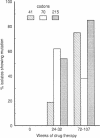Abstract
It is recognized that high-level resistance to 3'-azido-3'-deoxythymidine (AZT, zidovudine, or Retrovir) is conferred by the presence of four mutations in the human immunodeficiency virus (HIV) reverse transcriptase [RT; deoxynucleoside-triphosphate:DNA deoxynucleotidyltransferase (RNA-directed), EC 2.7.7.49] coding sequence. However, a number of clinical isolates have been observed that exhibit high-level resistance but contain only three of the four identified mutations (Asn-67, Arg-70, and Tyr-215). Construction of a molecular clone with this genotype gave rise to only a partially resistant virus, raising the possibility that an additional mutation existed in some clinical isolates. Using an HIV marker rescue system, we have mapped and identified a fifth mutation conferring resistance to zidovudine, namely, methionine to leucine at codon 41 of HIV RT. An infectious molecular clone containing this mutation together with three previously identified mutations in the RT coding sequence yielded highly resistant HIV after transfection of T cells. Direct detection of the fifth mutation in DNA samples from cocultured peripheral blood lymphocytes by the PCR revealed that it occurred relatively early in the development of zidovudine resistance. However, this mutation was only detected after the appearance of the codon 215 change in the RT coding sequence. Identification of this mutation in addition to the other known mutations conferring resistance enables rapid and direct correlation between an RT genotype and sensitivity of the virus.
Full text
PDF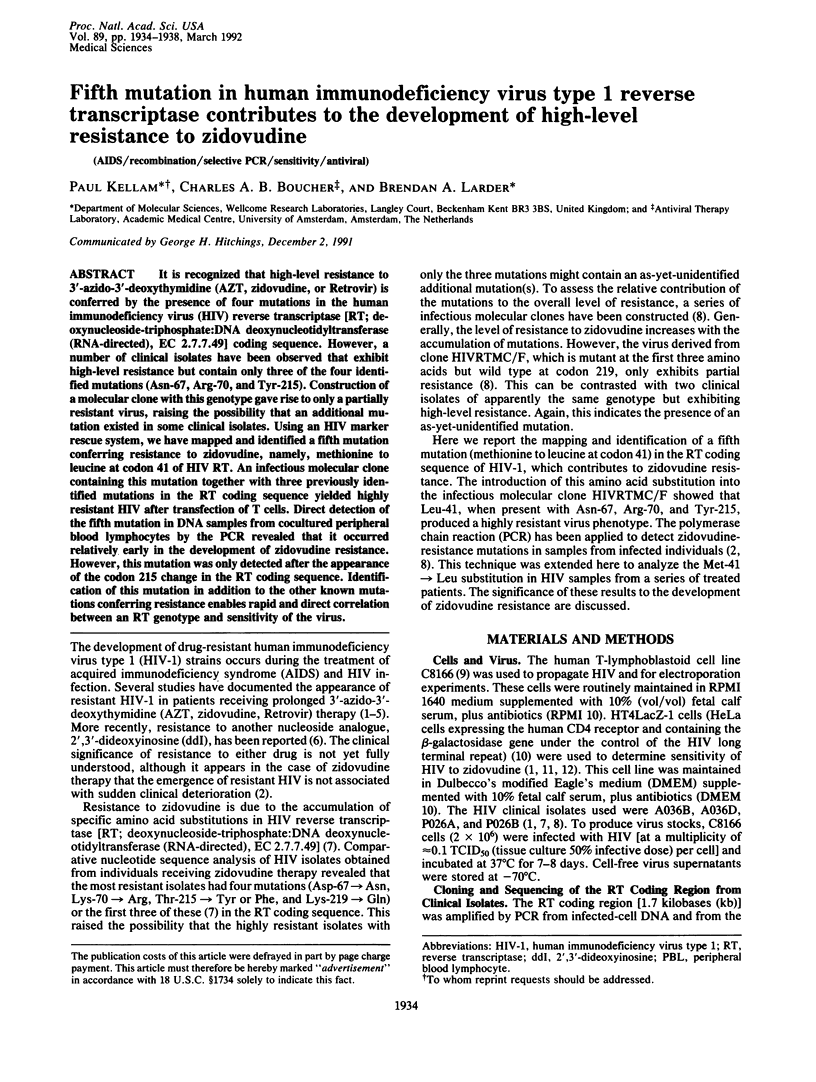
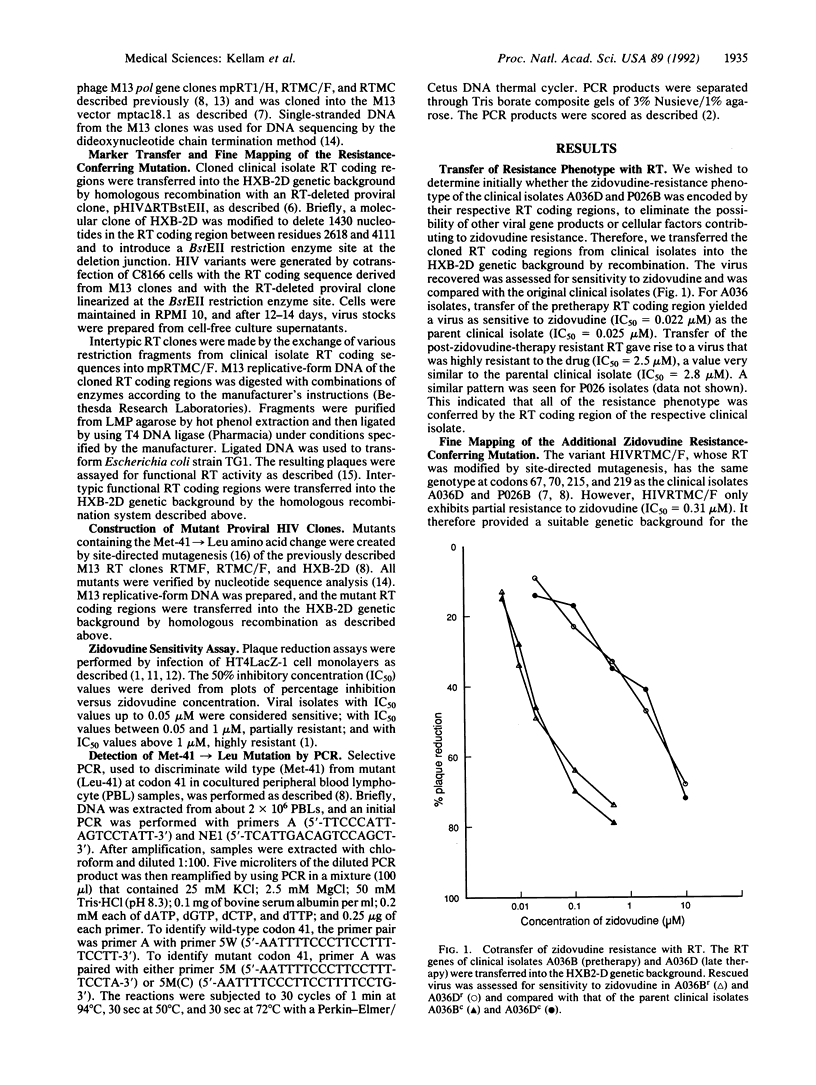
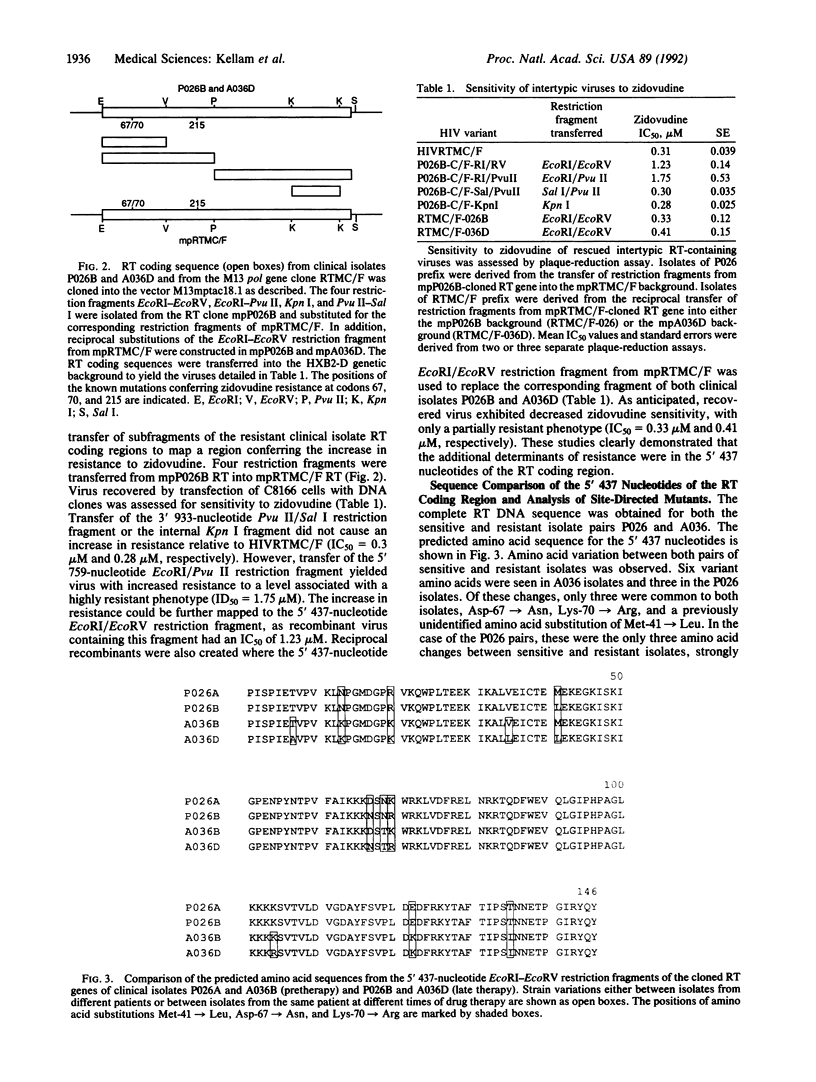
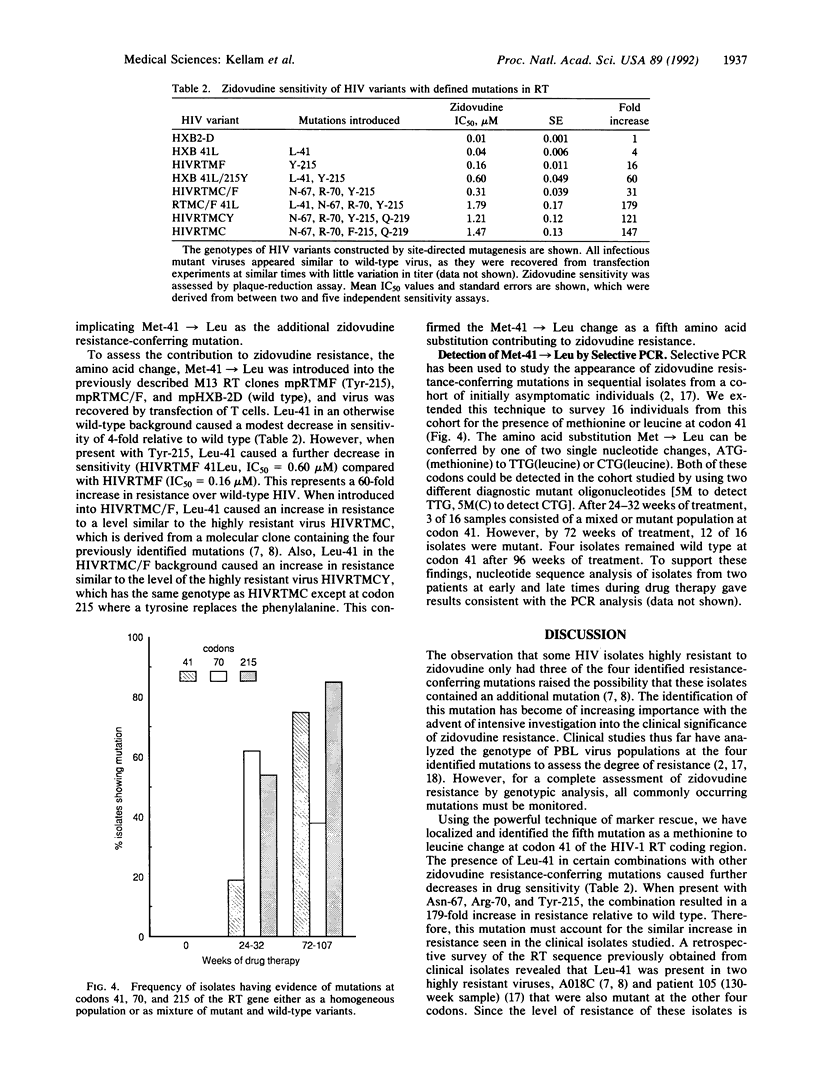
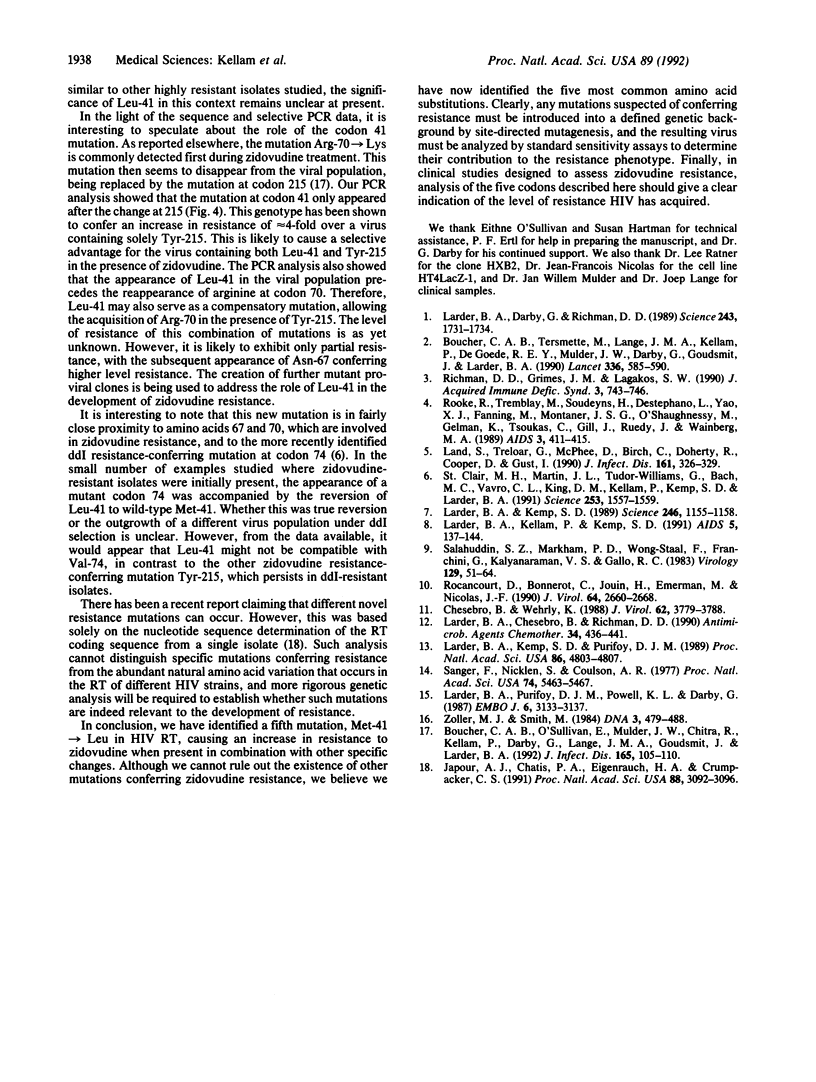
Images in this article
Selected References
These references are in PubMed. This may not be the complete list of references from this article.
- Boucher C. A., O'Sullivan E., Mulder J. W., Ramautarsing C., Kellam P., Darby G., Lange J. M., Goudsmit J., Larder B. A. Ordered appearance of zidovudine resistance mutations during treatment of 18 human immunodeficiency virus-positive subjects. J Infect Dis. 1992 Jan;165(1):105–110. doi: 10.1093/infdis/165.1.105. [DOI] [PubMed] [Google Scholar]
- Boucher C. A., Tersmette M., Lange J. M., Kellam P., de Goede R. E., Mulder J. W., Darby G., Goudsmit J., Larder B. A. Zidovudine sensitivity of human immunodeficiency viruses from high-risk, symptom-free individuals during therapy. Lancet. 1990 Sep 8;336(8715):585–590. doi: 10.1016/0140-6736(90)93391-2. [DOI] [PubMed] [Google Scholar]
- Chesebro B., Wehrly K. Development of a sensitive quantitative focal assay for human immunodeficiency virus infectivity. J Virol. 1988 Oct;62(10):3779–3788. doi: 10.1128/jvi.62.10.3779-3788.1988. [DOI] [PMC free article] [PubMed] [Google Scholar]
- Japour A. J., Chatis P. A., Eigenrauch H. A., Crumpacker C. S. Detection of human immunodeficiency virus type 1 clinical isolates with reduced sensitivity to zidovudine and dideoxyinosine by RNA.RNA hybridization. Proc Natl Acad Sci U S A. 1991 Apr 15;88(8):3092–3096. doi: 10.1073/pnas.88.8.3092. [DOI] [PMC free article] [PubMed] [Google Scholar]
- Land S., Terloar G., McPhee D., Birch C., Doherty R., Cooper D., Gust I. Decreased in vitro susceptibility to zidovudine of HIV isolates obtained from patients with AIDS. J Infect Dis. 1990 Feb;161(2):326–329. doi: 10.1093/infdis/161.2.326. [DOI] [PubMed] [Google Scholar]
- Larder B. A., Chesebro B., Richman D. D. Susceptibilities of zidovudine-susceptible and -resistant human immunodeficiency virus isolates to antiviral agents determined by using a quantitative plaque reduction assay. Antimicrob Agents Chemother. 1990 Mar;34(3):436–441. doi: 10.1128/aac.34.3.436. [DOI] [PMC free article] [PubMed] [Google Scholar]
- Larder B. A., Darby G., Richman D. D. HIV with reduced sensitivity to zidovudine (AZT) isolated during prolonged therapy. Science. 1989 Mar 31;243(4899):1731–1734. doi: 10.1126/science.2467383. [DOI] [PubMed] [Google Scholar]
- Larder B. A., Kellam P., Kemp S. D. Zidovudine resistance predicted by direct detection of mutations in DNA from HIV-infected lymphocytes. AIDS. 1991 Feb;5(2):137–144. doi: 10.1097/00002030-199102000-00002. [DOI] [PubMed] [Google Scholar]
- Larder B. A., Kemp S. D. Multiple mutations in HIV-1 reverse transcriptase confer high-level resistance to zidovudine (AZT). Science. 1989 Dec 1;246(4934):1155–1158. doi: 10.1126/science.2479983. [DOI] [PubMed] [Google Scholar]
- Larder B. A., Kemp S. D., Purifoy D. J. Infectious potential of human immunodeficiency virus type 1 reverse transcriptase mutants with altered inhibitor sensitivity. Proc Natl Acad Sci U S A. 1989 Jul;86(13):4803–4807. doi: 10.1073/pnas.86.13.4803. [DOI] [PMC free article] [PubMed] [Google Scholar]
- Larder B., Purifoy D., Powell K., Darby G. AIDS virus reverse transcriptase defined by high level expression in Escherichia coli. EMBO J. 1987 Oct;6(10):3133–3137. doi: 10.1002/j.1460-2075.1987.tb02623.x. [DOI] [PMC free article] [PubMed] [Google Scholar]
- Richman D. D., Grimes J. M., Lagakos S. W. Effect of stage of disease and drug dose on zidovudine susceptibilities of isolates of human immunodeficiency virus. J Acquir Immune Defic Syndr. 1990;3(8):743–746. [PubMed] [Google Scholar]
- Rocancourt D., Bonnerot C., Jouin H., Emerman M., Nicolas J. F. Activation of a beta-galactosidase recombinant provirus: application to titration of human immunodeficiency virus (HIV) and HIV-infected cells. J Virol. 1990 Jun;64(6):2660–2668. doi: 10.1128/jvi.64.6.2660-2668.1990. [DOI] [PMC free article] [PubMed] [Google Scholar]
- Rooke R., Tremblay M., Soudeyns H., DeStephano L., Yao X. J., Fanning M., Montaner J. S., O'Shaughnessy M., Gelmon K., Tsoukas C. Isolation of drug-resistant variants of HIV-1 from patients on long-term zidovudine therapy. Canadian Zidovudine Multi-Centre Study Group. AIDS. 1989 Jul;3(7):411–415. doi: 10.1097/00002030-198907000-00001. [DOI] [PubMed] [Google Scholar]
- Salahuddin S. Z., Markham P. D., Wong-Staal F., Franchini G., Kalyanaraman V. S., Gallo R. C. Restricted expression of human T-cell leukemia--lymphoma virus (HTLV) in transformed human umbilical cord blood lymphocytes. Virology. 1983 Aug;129(1):51–64. doi: 10.1016/0042-6822(83)90395-1. [DOI] [PubMed] [Google Scholar]
- Sanger F., Nicklen S., Coulson A. R. DNA sequencing with chain-terminating inhibitors. Proc Natl Acad Sci U S A. 1977 Dec;74(12):5463–5467. doi: 10.1073/pnas.74.12.5463. [DOI] [PMC free article] [PubMed] [Google Scholar]
- St Clair M. H., Martin J. L., Tudor-Williams G., Bach M. C., Vavro C. L., King D. M., Kellam P., Kemp S. D., Larder B. A. Resistance to ddI and sensitivity to AZT induced by a mutation in HIV-1 reverse transcriptase. Science. 1991 Sep 27;253(5027):1557–1559. doi: 10.1126/science.1716788. [DOI] [PubMed] [Google Scholar]
- Zoller M. J., Smith M. Oligonucleotide-directed mutagenesis: a simple method using two oligonucleotide primers and a single-stranded DNA template. DNA. 1984 Dec;3(6):479–488. doi: 10.1089/dna.1.1984.3.479. [DOI] [PubMed] [Google Scholar]




